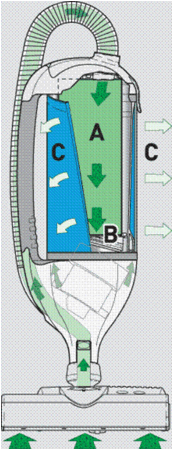SEBO have been instrumental in the development of the modern vacuum cleaner. They have introduced new technologies such as HEPA filters and electrostatic filtration to make machines which are more user friendly, more reliable, and give better performance. SEBO also work hard to manufacture in a way that is better for the environment.
Hoses on upright vacuum cleaners are now commonplace, but it was SEBO who originated the concept. SEBO's first upright model (the SEBO 350), on sale in 1978, featured the first built on hose and the first use of electrostatic filters. It also was the first upright to incorporate a clutch protected, timing belt driven, brush. The SEBO 350 also had the ability to lay completely flat and was light and easy to use. This machine was to become the worlds' biggest selling commercial upright vacuum cleaner, a position SEBO machines still enjoy.
In 1982, SEBO introduced duo-P carpet cleaning powder. In 1986 SEBO were the first company to make upright vacuum cleaners with electronic brush control and safety shut off. The built on hose with integrated wand was introduced in 1991.
Today you can see the development of these technologies in the SEBO automatic X range. S-Class electrostatic filter systems, a telescopic hose system, computer controlled height adjustment with auto safety shut-down, cassette style brush roller removal, permanent timing belts, and three layer bags for totally hygienic dust disposal.
SEBO are at the forefront of production technology and we test every single vacuum cleaner to ensure that every customer gets the best quality machine.
Electrostatic Filtration
Electrostatic filtration uses statically charged micro-fibres that attract dust particles from the air stream, these then bond onto the fibres. This enables the filter material to have a relatively open texture which allows a very good air flow for better suction performance, yet it also gives highly effective filtration.
S-Class Filtration
All SEBO vacuum cleaners either come with S-CLASS filtration, or can be easily upgraded to S-CLASS. To meet the S-CLASS standard the filtration system has to remove a minimum of 99.97% of particles of 0.3 microns. The SEBO S-CLASS system will remove 100% of particles of 1 micron and above. Dust mite faeces are approx. 10 microns.
 |
A = Bags are Better! Top-fill, three and four-layer bags are an integral part of SEBO’s filtration system because they hold virtually all dirt captured by the vacuum, which improves the effectiveness and useful life of the micro filters. They also ensure continuously strong suction because dirt enters from the top, deposits at the bottom, accumulates upward, and air exits through the sides, which allows unimpeded airflow as they fill to capacity. They can be sealed when full, so no dust can escape into the air during disposal. In contrast, without bags to hold nearly all the captured dirt, the micro filters on bagless vacuums quickly clog from excessive dirt build-up and must be replaced often or a loss of suction and cleaning effectiveness will occur. In addition, dust and other allergens become airborne when emptying the bagless dirt containers. Lastly, bagless vacuum micro filters are expensive, usually costing more than a multi-year supply of SEBO filter bags. B = S-class Micro filters. S-class (S =“Schwebstoff” = airborne particles) filters are made from electrostatically charged micro-fiber material, which attracts and captures dust particles from the airflow of the vacuum. The S-class Standard requires filters to absorb greater than 99.9% of particles down to 0.3 microns in diameter. Their advantages are a relatively open texture that allows smoother airflow for better suction performance, a long-lasting life expectancy, and they typically cost less than HEPA filters. The charged micro fibres block the dust particles and let un-rested air pass through. C = Exhaust Filter. The exhaust filter cleans the air emitted by the vacuum motor. |



